Muscat, Oman’s City in White

A young woman in her black abayah taking a photo with her Ipad is one way ot describing Oman today
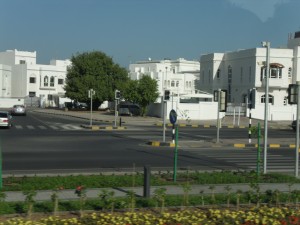 As soon as you drive out of the port area into Muscat, you begin to realize that almost all the buildings you are seeing are white. That’s not an accident. Apparently, the Sultan of Oman (doesn’t that sound exotic) has decreed that owners have a choice of five colors ranging from white to beige to paint their buildings and houses. He has also ordered that no building can have more than 17 stories. It makes for a clean, harmonious landscape with trees, flowers and a perpetual blue sky providing color.
As soon as you drive out of the port area into Muscat, you begin to realize that almost all the buildings you are seeing are white. That’s not an accident. Apparently, the Sultan of Oman (doesn’t that sound exotic) has decreed that owners have a choice of five colors ranging from white to beige to paint their buildings and houses. He has also ordered that no building can have more than 17 stories. It makes for a clean, harmonious landscape with trees, flowers and a perpetual blue sky providing color.
Situated in the southeastern corner of Arabia, Oman lies along the Gulf of Oman between the Straits of Hormuz on the east and Yemen on the west with Saudi Arabia and the United Arab Emirates on the north. The country is isolated from the rest of the Arabian Peninsula by the rocky, barren Hajjar Mountains rising immediately behind the coast and dominating the landscape. 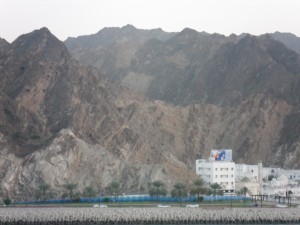
Muscat (or Masqaṭ in Arabic) with a metropolitan area of 580 sq. miles is the capital and largest city in Oman and seat of government. It has a population of about 800,000 or more than one million when the foreign workers are added.
Known as an important trading port between the west and the east as early as the first century AD, Muscat was ruled by various local tribes as well as foreign powers, including the Persians and Portuguese at various times in its history. Oman’s conversion to Islam occurred during the 7th century when it was conquered by the Abbasids of Baghdad. The Abbasids remained in the region until the 11th century, when they were driven out by a local tribe. Muscat prospered from maritime trade and close alliances with the Indian subcontinent, but at the expense of the people in Oman’s interior – a conflict that impacted the country down through the 20th century.
In 1507, the Portuguese conqueror Afonso de Albuquerque attacked Muscat and massacred most of the inhabitants. The Portuguese held Muscat for over a century, despite challenges from Persia and the Turks who captured it twice in the 17th century when it reverted to local Omanis after they forced the Portuguese to surrender in 1650.
A regional military power in the 18th century, Muscat’s influence extended as far as East Africa and Zanzibar. A civil war and Persian meddling destabilized the region, until the power vacuum was filled by Al Bu Sa‘id dynasty, which has ruled Oman since then. Muscat’s naval and military supremacy was re-established in the 19th century by Said bin Sultan, who signed a treaty with U.S. President Andrew Jackson’s representative Edmund Roberts on September 21, 1833. However, conflict among the tribes of the interior and with the Sultan of Muscat and Oman continued into the next century and eventually escalated into the Dhofar Rebellion in 1962.
The rebellion forced the Sultan Said bin Taimur to seek the assistance of the British in quelling the uprisings. After an assassination attempt on the Sultan in 1966 failed, he moved his residence from Muscat to Salalah. Then in 1970, Qaboos bin Said, the son of the Sultan, with British aid, staged a bloodless coup in the Salalah palace and took over as ruler. (Not to worry, Qaboos’ father lived out his elder years in residence at the famous Dorchester Hotel in London.)
Over the next three decades Qaboos bin Said moved steadily to modernize his country with rapid infrastructure and economic development based on trade and oil, bring Oman into the 20th century while maintaining a strong allegiance to its cultural heritage and its multi-ethnic society. He changed the name of the country from Muscat and Oman to the Sultanate of Oman, ended the Dhofar uprising, and consolidated disparate tribal territories. New ministries for social services such as health and education were established.
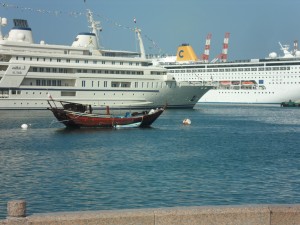 The Mina Sultan Qaboos, a new port where the water runs deep, was constructed, as was the Muscat International Airport where Oman Air is headquartered, 16 miles from the city center. A complex of offices, warehouses, shops and homes transformed the old village of Ruwi into Muscat’s main business and commercial district. The Muscat Securities Market, the principal stock exchange established in 1988, is located there and has distinguished itself as a pioneer for transparency and disclosure of regulations and requirements. The Petroleum Development Oman (PDO) has played a central role in the Muscat economy and is the country’s second largest employer, after the government.
The Mina Sultan Qaboos, a new port where the water runs deep, was constructed, as was the Muscat International Airport where Oman Air is headquartered, 16 miles from the city center. A complex of offices, warehouses, shops and homes transformed the old village of Ruwi into Muscat’s main business and commercial district. The Muscat Securities Market, the principal stock exchange established in 1988, is located there and has distinguished itself as a pioneer for transparency and disclosure of regulations and requirements. The Petroleum Development Oman (PDO) has played a central role in the Muscat economy and is the country’s second largest employer, after the government.
Mina Sultan Qaboos is now Muscat’s main port and a hub for trading between the Persian Gulf, the Indian subcontinent, and the Far East with an annual volume of about 1.6 million tons, despite competition from Jebel Ali Free Zone in neighboring Dubai.
The city has numerous mosques, Catholic and Protestant churches, and Hindu temples. Muscat’s museums and forts include Museum of Omani Heritage, National Museum of Oman, Oman Children’s Museum, Oman Natural History Museum, Bait al Zubair, Oman Oil and Gas Exhibition Centre, Omani French Museum, Sultan’s Armed Forces Museum and the Omani Aquarium and Marine Science and Fisheries Centre. The Al Falaj Fort played an important role in Muscat’s military history.
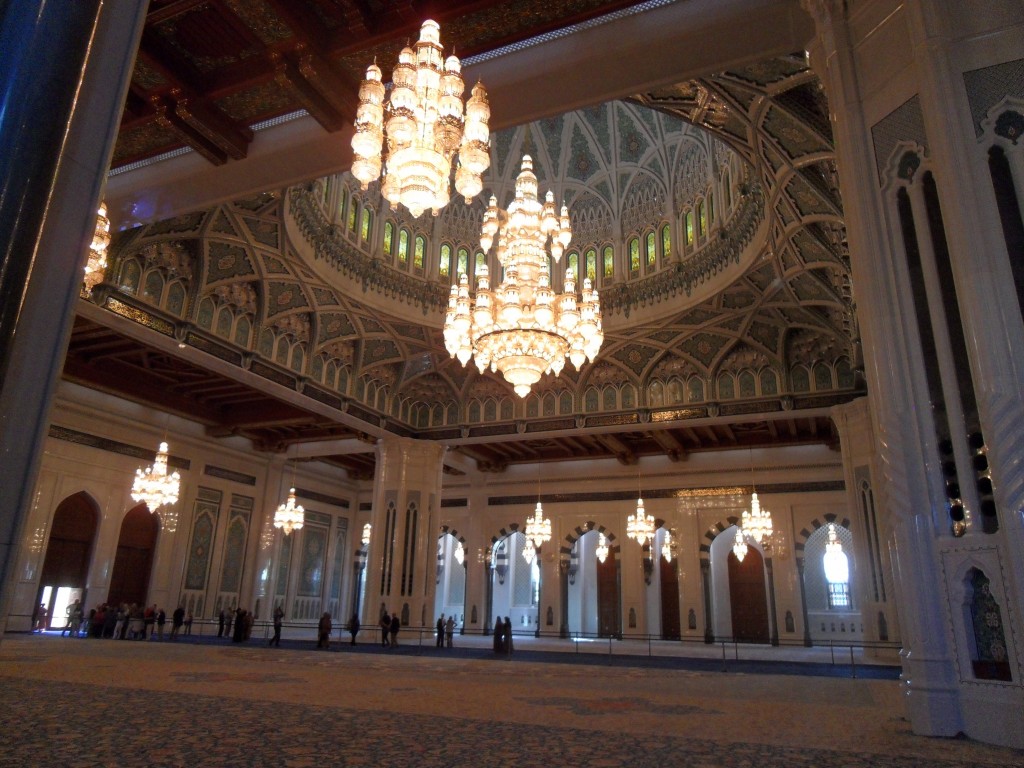 Sultan Qaboos Grand Mosque Located in the western part of Muscat, the Sultan Qaboos Grand Mosque was built to commemorate the 30th anniversary of Sultan Qaboos’ reign. The design was the winning entry of an international competition and took six years to build. Opened in 2004, the mosque is a large, graceful complex that combines Arab and Islamic architecture and serves as a scientific, research, and intellectual center as well as a place of worship. Covering an area of approximately 4,478 sq. ft. with a capacity for 20,000 worshipers, it is centered by a large prayer hall which can accommodate 6,500 worshipers at one time.
Sultan Qaboos Grand Mosque Located in the western part of Muscat, the Sultan Qaboos Grand Mosque was built to commemorate the 30th anniversary of Sultan Qaboos’ reign. The design was the winning entry of an international competition and took six years to build. Opened in 2004, the mosque is a large, graceful complex that combines Arab and Islamic architecture and serves as a scientific, research, and intellectual center as well as a place of worship. Covering an area of approximately 4,478 sq. ft. with a capacity for 20,000 worshipers, it is centered by a large prayer hall which can accommodate 6,500 worshipers at one time.
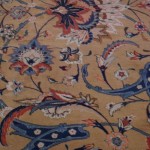 The mosque’s most famous feature is the carpet covering the prayer hall floor, which is said to be the second largest single Persian carpet in the world. It took several dozen weavers using 28 different colors made from plant or natural dyes in varying gradations, almost four years to complete and weighs 21 tons. The beautiful central dome is illuminated by a sparkling Swarovski crystal chandelier rising 165 feet overhead.
The mosque’s most famous feature is the carpet covering the prayer hall floor, which is said to be the second largest single Persian carpet in the world. It took several dozen weavers using 28 different colors made from plant or natural dyes in varying gradations, almost four years to complete and weighs 21 tons. The beautiful central dome is illuminated by a sparkling Swarovski crystal chandelier rising 165 feet overhead.
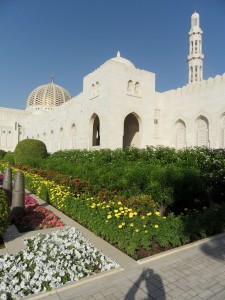 The mosque has five minarets, symbolizing the five pillars of Islam. Surrounding the mosque building are corridors up to 800 feet long with high pointed arches. The walls of the mosque and inter courtyard are inscribed with verses from the Koran. The interior walls of the mosque’s main hall are completely covered with white and dark grey marble. Timber panels stretch in a fashion that reflects the architectural development of Omani ceilings.
The mosque has five minarets, symbolizing the five pillars of Islam. Surrounding the mosque building are corridors up to 800 feet long with high pointed arches. The walls of the mosque and inter courtyard are inscribed with verses from the Koran. The interior walls of the mosque’s main hall are completely covered with white and dark grey marble. Timber panels stretch in a fashion that reflects the architectural development of Omani ceilings.
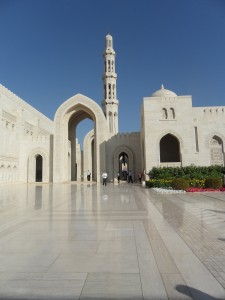 The corridors are divided into halls: The north and south corridors constitute the boundary between the places of worship and the mosque’s other facilities, including a library that contains 20,000 reference volumes in science, Islamic culture and humanity, and the Institute of Islamic Sciences where young people learn the religious disciplines. A hall for meetings and seminars can accommodate 300 people. The buildings are surrounded on all sides with lovely flowering gardens.
The corridors are divided into halls: The north and south corridors constitute the boundary between the places of worship and the mosque’s other facilities, including a library that contains 20,000 reference volumes in science, Islamic culture and humanity, and the Institute of Islamic Sciences where young people learn the religious disciplines. A hall for meetings and seminars can accommodate 300 people. The buildings are surrounded on all sides with lovely flowering gardens.
Non-Muslims may visit the mosque every day from 8:30 a.m. to 11:00 a.m. except Friday. Visitors must remove their shoes to enter the prayer areas and are asked to dress modestly; women must cover their hair. Address: Ghubrah, Ruwi, Muscat 112.
Royal Opera House Muscat Another amazing building in the Al-Qurm district is the Royal Opera House which is the venue for a full schedule of concerts, ballet, operas and other performing arts by regional and visiting artists and has hosted such famous artists as Placido Domingo and Rene Fleming of the Metropolitan Opera in New York. When it opened in October 2011, Oman’s Royal Opera House was the first of its kind in the Middle East with advanced technology used in its operation. For example, it was designed to change its seating capacity to accommodate the type of function involved. The opera house has 6 levels and 3 basement floors and can seat 1,000 people for concert and opera. The exterior of the main structure is finished in Omani marble. Address: Al Kharjiyah St, Muscat; tel. +968 24 403300
Oman National Museum Another notable project is the Oman National Museum which from the artist’s rendering and early photographs is an architectural jewel, created by Arts Architecture in conjunction with museum designers Jasper Jacob Associates. Situated in the center of Old Muscat, the National Museum will showcase the cultural heritage of Oman from prehistoric times to the present day. The main entrance is a new public square and leads to The Land and The People, a central, air-conditioned triple-height space celebrating the different regions of the country and around which the other galleries are set.
The ground floor galleries include Maritime Heritage, and Arms and Armor, among others. An archaeological timeline – a staircase giving an overview of 10,000 years of Omani prehistory and history – brings the visitor to the first floor historic galleries: Prehistory and Ancient History; The Splendors of Islam; and Oman & the World, and culminates in The Renaissance, the story of modern Oman. Further galleries cover music, storytelling, dance and cookery. Collections is an open storage gallery with public access to the collections’ database.
Other facilities include an AV theatre, exhibition space, shop, corporate entertaining suite, and an education center with facilities for schools, seminar rooms, and an 80-seat lecture theatre, as well as prayer rooms, conservation, administrative and collections management facilities. A wing with a café will overlook a courtyard garden with outdoor exhibits including ancient rock art. The museum is scheduled to open in June 2014.
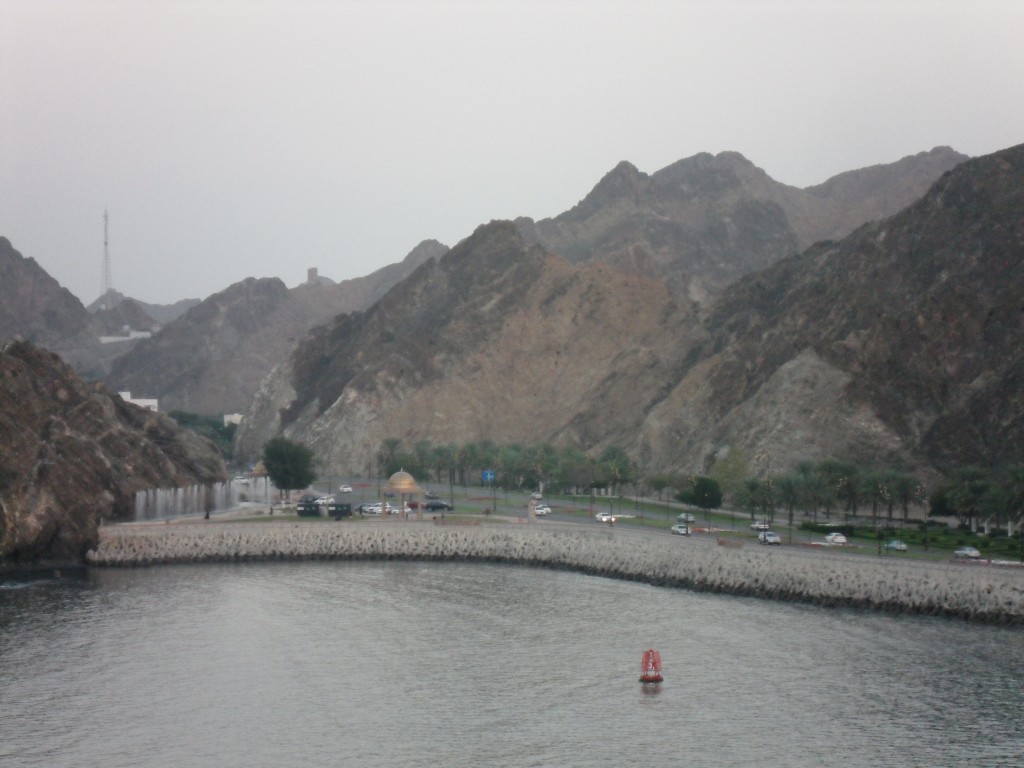 Old Muscat is located along Mutrah Corniche, a road that follows, more or less, the coast from Sultan Qaboos Port to Al Bustan Beach. It is surrounded by a wall built in 1625 on its southern and western sides, while the mountains and the Gulf of Oman were the natural barriers to the north and east.
Old Muscat is located along Mutrah Corniche, a road that follows, more or less, the coast from Sultan Qaboos Port to Al Bustan Beach. It is surrounded by a wall built in 1625 on its southern and western sides, while the mountains and the Gulf of Oman were the natural barriers to the north and east.
13967 Mutrah Souq Directly behind the Sultan Qaboos Port is one of the oldest markets in Oman, dating back about two hundred years. Mutrah is typical of traditional Eastern markets, with narrow winding alleys roofed with wood and lined by shops selling everything from jewelry and perfumes to kitchenware and luggage. The souq has sections: The east and west parts, separated by Khawr Bimbah, are known as “the small market” and “the large market,” the latter being the wholesale market. Most visitors will be interested in the handicrafts like silverware 13971and daggers, antiques, 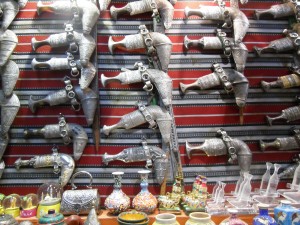 and Omani sweets, spices and braziers in which incense or frankincense is burned. The souq is open daily, except Friday, from 8:00 a.m. to 1:00 p.m. and 4:00 p.m. to 8 p.m., however, on my visit, not all shop closed for lunch, particularly when there are cruise ships in port.
and Omani sweets, spices and braziers in which incense or frankincense is burned. The souq is open daily, except Friday, from 8:00 a.m. to 1:00 p.m. and 4:00 p.m. to 8 p.m., however, on my visit, not all shop closed for lunch, particularly when there are cruise ships in port.
14026/063 Mutrah Fort On top of a rocky, narrow hill, Mutrah Fort stands facing the sea. The fort consists of three circular towers: a huge one sitting on the summit and a smaller one is on the West, and 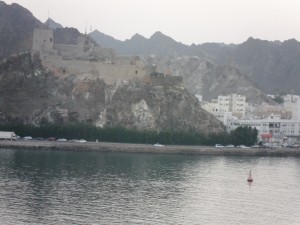 the other, which still houses an old cannon, on the north. The fort is currently being renovated and not open to visitors.
the other, which still houses an old cannon, on the north. The fort is currently being renovated and not open to visitors.
14000 Bait al Zubair A private home belonging to the Zubair family was opened to the public as a museum in 1998. It houses the family’s private collection and includes Omani artifacts of historic significance. In the garden outside there are several exhibits including a traditional house and a boat made from palm reeds, typical kitchen and other utensils, a small dhow, and a display of Muscat-in-miniature. Visitors are not allowed to photograph inside the house but can take pictures of the exhibits in the garden. The museum is open daily except Friday; there is an entrance fee.
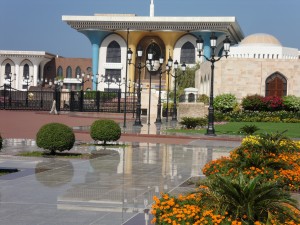 Al Alam Royal Palace The palace, located at the head of a natural harbor and guarded by the Al Jalali and Al Mirani forts, is the official office of the Sultan of Oman. Visitors are allowed to walk in the gardens but the palace is not open to the public. To my surprise, the traffic of several city streets crosses the grounds directly in front of the palace. 14023
Al Alam Royal Palace The palace, located at the head of a natural harbor and guarded by the Al Jalali and Al Mirani forts, is the official office of the Sultan of Oman. Visitors are allowed to walk in the gardens but the palace is not open to the public. To my surprise, the traffic of several city streets crosses the grounds directly in front of the palace. 14023
Big (red) Bus Probably the easiest, most convenient and least costly way to familiarize yourself with Muscat is a tour with commentary on the hop on/hop off Big (red) Bus. It offers a circuit with 10 stops, plus a free walking tour and free shuttle service to the Sultan Qaboos Grand Mosque. The tour starts from the main entrance of the Mutrah Souq which is within walking distance of 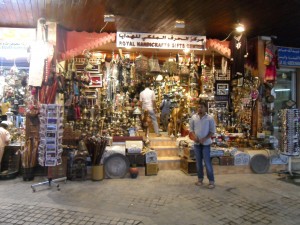 the Mina Sultan Qaboos where cruise ships dock.
the Mina Sultan Qaboos where cruise ships dock.
It passes through the main parts of town giving access to churches and Hindu temple as well as the business district, and continues west to the newest, most affluent area with the Royal Opera House, restaurants, shops and access to the beach. It continues to another area with access to the beach and to Al Qurm National Park. Al Qurm commercial area is the main shopping district for modern stores, but there are shopping malls throughout the city. The last leg retraces some of the earlier route via the business district and then runs east to the Parliament complex, the Yacht Club and marina, and finally to the Sultan’s headquarters, Al Alam Palace, and several museums and forts in the area, and along the Corniche by the sea and back to starting place in front of the Mutrah Souq. For information: www.bigbustours.com; infomuscat@bigbustours.com; tel. +968 245 23112.
Muscat is well served by good roads while highways connect most of the country’s major cities and towns. Oman has no rail or metro network. The most popular public transportation is the relatively inexpensive “Baiza” bus, so named for the lower denomination of the Omani rial. They serve major roadways and smaller ones in the Muscat metropolitan area, dropping off and picking up passengers at any location. Slightly more expensive, large red green public buses serve major roadways and point-to-point travel between Oman’s major towns. Taxis — orange and white – are available for individual hire and also serve on routes similar to Baiza buses. Taxis are not metered, so the fare must be negotiated. It’s best to know the approximate fare by asking your hotel or an acquaintance the rate so not to appear unfamiliar with the area.
By Kay Showker aboard Oceania Cruises’ Nautica, somewhere in the Indian Ocean

Leave a Reply